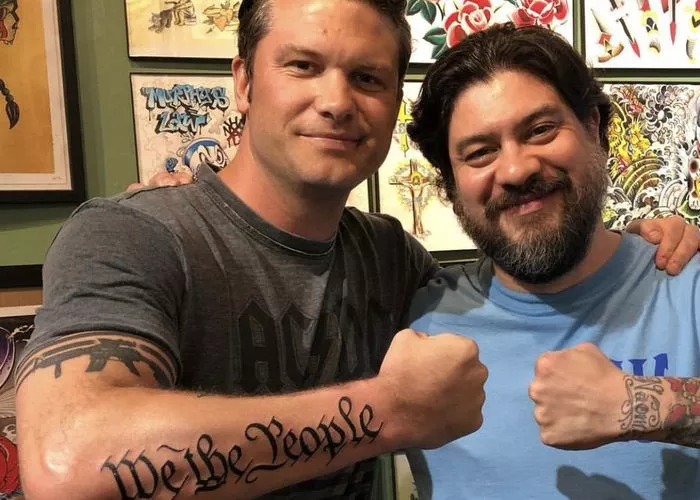Pete Hegseth, President-Elect Donald Trump’s controversial nominee for Secretary of Defense, is a decorated war veteran, Ivy League graduate, and a two-time Bronze Star recipient. However, it’s not just his military background or educational achievements that have caught attention — Hegseth is also known for his extensive tattoo collection.
The 44-year-old, who has served tours in both Afghanistan and Iraq, has more than a dozen tattoos that cover his right arm and chest. His tattoos, which include religious and patriotic symbols, have stirred controversy, particularly given his high-profile position within the National Guard and his public stance on various issues.
Jerusalem Cross
One of Hegseth’s most prominent tattoos is the Jerusalem Cross, a large cross surrounded by four smaller crosses. Dating back to the Crusades, the symbol has recently been linked to Christian nationalism, and its presence on Hegseth’s chest has made headlines. In 2021, Hegseth claimed that he was ordered to stand down from guarding President Joe Biden’s inauguration because of this tattoo. He asserted that the Jerusalem Cross led to accusations of extremism, resulting in the revocation of his orders.
Deus Vult
Another tattoo on Hegseth’s bicep features the phrase “Deus Vult,” Latin for “God wills it.” This phrase is tied to the First Crusade, when it was reportedly used as a battle cry for Christian crusaders. Hegseth’s tattoo also serves as a reference to his book American Crusade, in which the phrase is mentioned.
Cross and Sword with Hebrew Script
On his arm, Hegseth also sports a cross intertwined with a sword, a design inspired by the New Testament verse Matthew 10:34, which says, “I have not come to bring peace, but a sword.” This tattoo was his first and was done while on vacation with his family. Later, while working on a Fox series, he added Hebrew lettering that spells out “Yahweh,” the biblical name for God, though the translation is officially understood as “I am” or “He will be.”
Chi-Rho
Hegseth’s tattoos include a symbol of early Christianity in the form of the Greek letters Chi (X) and Rho (P), which represent the word “Christ.” These letters, often used as a monogram for Christ, reflect his affinity for religious symbolism.
We the People and Patriotic Tattoos
Hegseth’s tattoos also express his strong sense of patriotism. On his forearm, he has the phrase “We the People,” a reference to the U.S. Constitution. Above it is the year 1775 in Roman numerals, commemorating the year Georgia joined the other 12 colonies at the Second Continental Congress. Surrounding this tattoo are 13 stars, symbolizing the original colonies.
Join, or Die Snake
Another tattoo inspired by the American Revolution features the famous “Join, or Die” snake, which Hegseth has inked on his inside forearm. Originally published in Benjamin Franklin’s Pennsylvania Gazette in 1754, the image was meant to encourage unity among the colonies during the French and Indian War. It has since become an iconic symbol of colonial independence.
American Flag and AR-15
Hegseth’s upper arm is adorned with a tattoo of the American flag, which includes an AR-15 rifle as part of the flag’s stripes. Hegseth has stated that the rifle depicted is the same AR-15 he carried during his deployment in Iraq, further cementing the tattoo’s personal and military significance.
Infantry Regiment Patch
One of Hegseth’s largest tattoos is the patch of his Army regiment, the 187th Infantry. The regiment, which dates back to World War II, is known for its role as a glider unit. Hegseth’s tattoo features the regiment’s coat of arms, which includes a sword pointing upward, and its motto.
Hegseth’s tattoos not only reflect his military service and deep personal beliefs but also spark ongoing debates surrounding the intersection of personal expression, religion, and patriotism. As he continues his public career, these tattoos remain a key part of his identity.
Related topics:

